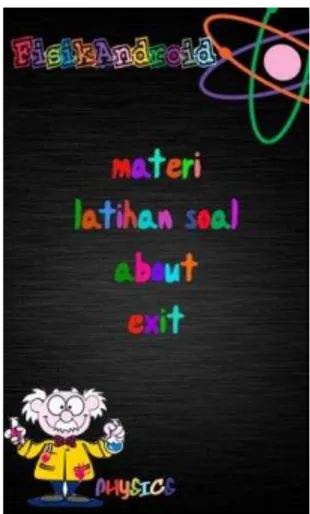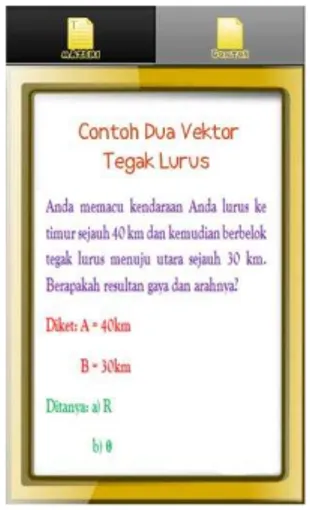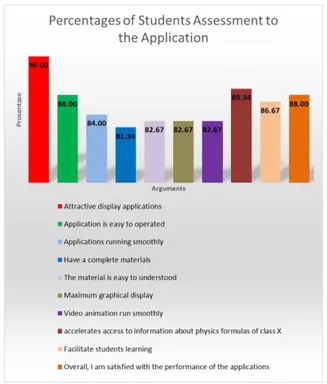PHYSICS FORMULA APPLICATION
BASED ON MOBILE ANDROID
FOR TENTH GRADE HIGH SCHOOL
PUBLICATION ARTICLE
By:
Ida Yunita
Endah Sudarmilah, S.T, M.Eng
Yusuf Sulistyo Nugroho, S.T, M.Eng
DEPARTMENT OF INFORMATICS
FACULTY OF COMMUNICATIONS AND INFORMATICS
UNIVERSITAS MUHAMMADIYAH SURAKARTA
PHYSICS FORMULA APPLICATION
BASED ON MOBILE ANDROID
FOR TENTH GRADE HIGH SCHOOL
Ida Yunita, Endah Sudarmilah, Yusuf Sulistyo Nugroho
Department of Informatics, Faculty of Communications and Informatics, Universitas Muhammadiyah Surakarta
Email: [email protected]
ABSTRACT
The aim of design and building Fisikandroid application is presenting an education application based on mobile android that contains physics formulas with more attractive material so it will easy to be understood by students. Trial application respondent is students of SMA N 2 Sukoharjo. Methods of data collection are questionnaire and comparison of pretest result. The end result of this research is an educational application based on mobile android that contains the physics formulas of class X, which presented more attractive and easy to be understood by students. It is proved from the questionnaire that 86.67% of respondents agreed if this application has elements of education, 96% of respondents stated this is an attractive application, 82.67% respondents agreed the information in this application is easy to understand, and 86.67% of students experienced increases in value after using this application which means that this application can improve students understanding of the material presented.
Key Word: Android, Physics, Fisikandroid, Education
INTRODUCTION
The development of information systems and technology are now growing rapidly (Supriyanto, 2005). Along with the development of these technologies, an
A smartphone is supported with a default operating system, one of the operating systems that is growing now is the android (Safaat, 2011). Android is an operating system for smartphones which is developed by Google. The open sources have the impact on the increasing number of users and developers significantly (Huda, 2012).
Physics is one of sciences that studies the universe. Due to the implementation of physics are found in everyday life, physics becomes the basis for future technological mastery (Indrajit, 2009). Conceptually, physics contains many formulas that make students are not interested to learn or memorize and understand it. Moreover, the complicated questions cause physics becomes the difficult subject (Sugiharti, 2005). Because of the reason, presenting the materials and physics formulas attractively and colorful with additional video animation are attempted to increase students’ interest in
learning physics and to make the students more understand the materials.
Therefore, the author raised the title “Physics Formula Application Based on
Mobile Android for Tenth Grade High School”.
LITERATURE REVIEW
According to Wijaya (2012), in his journal entitled "Aplikasi Kimiandroid Pada Ponsel Berbasis Android ",
kimiandroid application is an educative application to help the learning activity, especially in chemistry. Kimiandroid
application had been tested, and it could run quite well on the Samsung Galaxy Mini GT-S5570 Android operating system 2.2 or Froyo (Frozen Yogurt).
Meanwhile, according to Aripurnamayana (2012) in his journal entitled "Rancangan Dan Pembuatan
Mobile Learning Berbasis Android (Studi Kasus: Pembelajaran Sejarah Di Smp)", some alternative methods in relation with the modification in teaching history need to be developed. One of the methods that I think could be applied is the use of audiovisual media via mobile learning. The purpose of this study is to develop eighth grade students’ interest in history and as the
interactive media in learning history which is more interesting. The try out had been done on the emulator 2.1 and emulator 2.2. The program implementation was done on has faster speed access.
In manuscript publication entitled
"Perancangan Aplikasi Rumus-Rumus
Fisika Berbasis Android" compiled by Latif (2012) said that to make it easier for students to learn physics formula, then it needs a new method which is easier and more enjoyable so that it can increase students’ interest in learning. Learning
media that are moveable (easy to carry around) would be more effective. The design of this Android system was accomplished by designing the UML, using case diagrams, class diagrams, and sequence diagrams, designing ERD, designing database, and designing graphic. The results of this study is the use of mobile media in conveying information about the discussion of physic materials such as
massa jenis, kalor, pemuaian, kelajuan,
There is also a menu of test questions used for exercising after learning or reading material.
In the journal entitled "Rancang Bangun Model Pembelajaran Fisika SMA
Dengan Flash (Studi Kasus Gerak Benda)"
by Santi, et al, (2009), the multimedia aspects supported an application in the manufacture of instructional applications. This was because multimedia was the integration of audio, video, text, animation and graphics in a digital interactive environment. This study built a Physics Teaching Tool Application using Macromedia Flash 8, which can assist in the learning process. This study provides a good interface learning materials which is user-friendly and also creates a way to keep children from the saturation while studying.
RESEARCH METHODOLOGY
a. SDLC (System Development Life
Cycle)
The research method used is SDLC (System Development Life
Cycle), a method that describes the system development life cycle in the design and development of information systems. SDLC has had several phases, starting from beginning stage up to the last stage and back again to the beginning stage form a cycle or life cycle (Jogiyanto, 2005).
Figure 1 Flowchart SDLC
The stages of SDLC methods are: 1. Requirements definition stage was
was also conducted to allow an designing the user interface which includes appearance, content and the design of Physics Formula Application Based on Mobile Android for Tenth Grade High School complete with the exercises and evaluation to measure users’ level of understanding the material. 4. System development stage or
program coding was the implementation phase of the design stage done by using a supporting software programmer. This
instructional media application development used Eclipse Helios 3.6.2 software.
5. Testing system was the try out or testing stage of the learning media
application before the application can
be used fully. The purpose of testing
was to make the system run smoothly
and free from errors, and the result can
be accordance with the design and user
needs.
b. Designing
The UML designing only includes the Use Case designing. Based on the analysis of learning needs of the media system, a use case of the system that will be built can be made. The Use case itself includes, use case diagrams, actor definitions and use case definition. 1. Use Case Diagram
Use case diagram is used to illustrate the facilities given by this application for the users. The users consist of teachers and students. "Figure 2 Use Case Diagram" explains that the user as an operator get the full facilities to open and operate any information and evaluation exercises provided in the
Fisikandroid application. This application has a static character and not uses the database as the data storage media so the user cannot change the content of information and practice questions.
2. Actor Definition
Describes the facility that can user get from Physics Formula Application Based on Mobile Android for Tenth Grade High School. User is the people who have to access the information of application and do the exercises and
evaluations that are available in the application.
3. Use Case Definition
The following is the use case definition that includes Physics formula materials and evaluation. a) Physics Formula Materials
In this section the users can open the materials of physics formulas with example of the questions.
b) Exercises and Evaluation Test In this section the user can do the exercises and evaluation to measure the level of understanding of the material.
application while operating, as well as make improvements performance less than the maximum.
2. External
External testing in this research divided in to three ways there are by comparing the exercises result before and after using this application, by using questionnaires and by testing the system itself. Formula to calculate score of questionnaires
Ideal Score / Maximum Score
(SMax) = 5 x n = 5n (SA) Minimum Score (SMin)
1 x n = n (SDA) n = total respondents
Score (S) = ∑ (Total Respondent Answer Voters x Weights Answers) Interpretation percentage (P) percentage rate of Interpretation (P), i.e. the interval scales (Riduwan et al, 2007) as follows:
81 – 100 (very strongly)
The results applications from this research with the tittle “Physics Formula
Application Based on Mobile Android for Tenth Grade High School” follows are:
a. Splash Screen Page
Figure 3 Splash Screen Page
b. Main Menu Page
The main menu page of
Fisikandroid application contains of
materi, latihan soal, about and exit.
Materi button contains of materials of tenth grade high school that are Vektor, Gerak dalam Satu Dimensi, Gerak
Melingkar, Dinamika Gerak, Alat
Optik, Kalor, Elektrodinamika,
Elektromagnetik. And for the Latihan Soal button contains of sub-menu
latihan soal and evaluasi. Personal data of programmer contained in the About button. Main menu page will show in figure 4
Figure 4 Main Menu Page
c. Material Page
Material page contains page that contains the formulas with liltle explanations, example problems and video animation. Material page show in figure 5 and 6
Figure 6 Example Page
And this is of video animation page
Figure 7 Display of Animation Video
Page
d. Exercise and Evaluation Page
Exercise page contains of random practice questions with multiple choice answers. If the answer false it will appear the dialog to go to the information page, if the answers true it will go to the next question.
Figure 8 Exercises Page
Evaluation page contains of 20 random questions with multiple choice answer. In the end of this session will appear display of evaluation results.
Figure 9 Evaluation Page
Figure 10 Percentages of Students
Assessment to the Application
Based on the result of questionnaire can be conclude that 96% of respondents said this is application has attractive display applications. And this application can easy to operate, this reinforced if 88% agreed with this statement. Around of 80% of respondents says if this application and video run smoothly, has completed material and maximum graphical display on easy to be understood.
For the research of comparative results before and after using application
with the same types of questions state that from 15 students, 86.67% students having increases in value. It is proved that this application can improve the student understanding of the material that presented in the Physics Formula Application Based on Mobile Android for Tenth Grade High School.
CONCLUSION
Based on design, development, implementation and research of Physics Formula Application Based on Mobile Android for Tenth Grade High School that has been done, can be concluded that:
1. This application has elements of education, this is proved in the results of the research in Chapter IV which states 86.67% of respondents agreed if this application helps facilitate student learning.
that 96% of respondents agreed with this statement.
3. Information in this application is easy to be understood, this is strengthened by the results of research that 82.67% of respondents agreed with this statement.
4. This application can improve the student understanding of the material which presented in the
application, this is proved in Chapter IV research results that 86.67% of students has increased the value.
BIBLIOGRAPHY
Aripurnamayana, M. Irfan, 2012. Rancangan Dan Pembuatan Mobile Learning Berbasis Android (Studi Kasus : Pembelajaran Sejarah Di Smp). Jurnal. Depok : Universitas Gunadarma.
Handayani, Sri, dkk. 2009. FISIKA Untuk SMA dan MA Kelas X. Pademangan : Pusat Pembukuan Departemen Pendidikan Nasional.
Huda, Arif Akbarul. 2012. 24jam!! Pintar Pemrograman Android. Yogyakarta: Penerbit Andi.
Jogiyanto. 2005. Sistem Teknologi Informasi. Yogyakarta : Andi.
Latif, Muhammad Abdul. 2012. Perancangan Aplikasi Rumus-Rumus Fisika Berbasis Android. Jurnal. Yogyakarta : Stmik AmikomYogyakarta.
Riduwan and Akdon. 2007. Rumus dan Data dalam Analisis Statistika. Bandung: Alfabeta.
Safaat, Nazruddin. 2011. Android Pemrograman Aplikasi Mobile Smartphone dan Tablet PC Berbasis Android. Bandung: Informatika.
Santi, Rina Candra Noor, dkk.2009. Rancang Bangun Model Pembelajaran Fisika Sma Dengan Flash (Studi Kasus Gerak Benda).Jurnal Publikasi. Semarang : Universitas Stikubank Semarang.
Saripudin, Aip, dkk. 2009.Praktis Belajar Fisika 1 Untuk SMA/MA Kelas X. Pademangan : Pusat Pembukuan Departemen Pendidikan Nasional.
Septiawan, Arif Tri. 2012. “Pengenalan Dan Pembelajaran Cara Membaca Alquran (Ilmu Tajwid) Berbasis Mobile Android”. Skripsi. Surakarta: Universitas Muhammadiyah Surakarta.
Sugiharti, Piping, S,pd. 2005. Penerapan Teori Multiple Intelligence dalam Pembelajaran Fisika. Jurnal Pendidikan Penabur.
Supriyanto, Aji. 2005. Pengantar Teknologi Informasi. Jakarta : Salemba Infotek.
Widodo, Tri. 2009. FISIKA Untuk SMA/MA Kelas X. Pademangan : Pusat Pembukuan Departemen Pendidikan Nasional.
Wijaya, Fenny Anggraeni. 2012. Aplikasi Kimiandroid Pada Ponsel Berbasis Android.


